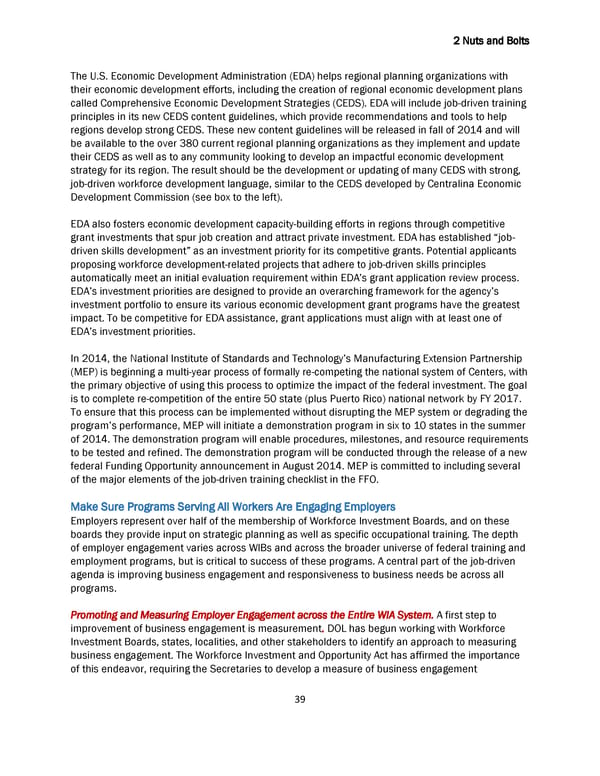2 Nuts and Bolts The U.S. Economic Development Administration (EDA) helps regional planning organizations with their economic development efforts, including the creation of regional economic development plans called Comprehensive Economic Development Strategies (CEDS). EDA will include job-driven training principles in its new CEDS content guidelines, which provide recommendations and tools to help regions develop strong CEDS. These new content guidelines will be released in fall of 2014 and will be available to the over 380 current regional planning organizations as they implement and update their CEDS as well as to any community looking to develop an impactful economic development strategy for its region. The result should be the development or updating of many CEDS with strong, job-driven workforce development language, similar to the CEDS developed by Centralina Economic Development Commission (see box to the left). EDA also fosters economic development capacity-building efforts in regions through competitive grant investments that spur job creation and attract private investment. EDA has established “job- driven skills development” as an investment priority for its competitive grants. Potential applicants proposing workforce development-related projects that adhere to job-driven skills principles automatically meet an initial evaluation requirement within EDA’s grant application review process. EDA’s investment priorities are designed to provide an overarching framework for the agency’s investment portfolio to ensure its various economic development grant programs have the greatest impact. To be competitive for EDA assistance, grant applications must align with at least one of EDA’s investment priorities. In 2014, the National Institute of Standards and Technology’s Manufacturing Extension Partnership (MEP) is beginning a multi-year process of formally re-competing the national system of Centers, with the primary objective of using this process to optimize the impact of the federal investment. The goal is to complete re-competition of the entire 50 state (plus Puerto Rico) national network by FY 2017. To ensure that this process can be implemented without disrupting the MEP system or degrading the program’s performance, MEP will initiate a demonstration program in six to 10 states in the summer of 2014. The demonstration program will enable procedures, milestones, and resource requirements to be tested and refined. The demonstration program will be conducted through the release of a new federal Funding Opportunity announcement in August 2014. MEP is committed to including several of the major elements of the job-driven training checklist in the FFO. Make Sure Programs Serving All Workers Are Engaging Employers Employers represent over half of the membership of Workforce Investment Boards, and on these boards they provide input on strategic planning as well as specific occupational training. The depth of employer engagement varies across WIBs and across the broader universe of federal training and employment programs, but is critical to success of these programs. A central part of the job-driven agenda is improving business engagement and responsiveness to business needs be across all programs. Promoting and Measuring Employer Engagement across the Entire WIA System. A first step to improvement of business engagement is measurement. DOL has begun working with Workforce Investment Boards, states, localities, and other stakeholders to identify an approach to measuring business engagement. The Workforce Investment and Opportunity Act has affirmed the importance of this endeavor, requiring the Secretaries to develop a measure of business engagement 39
 Biden Ready to Work White Paper 7/22/14 Page 38 Page 40
Biden Ready to Work White Paper 7/22/14 Page 38 Page 40